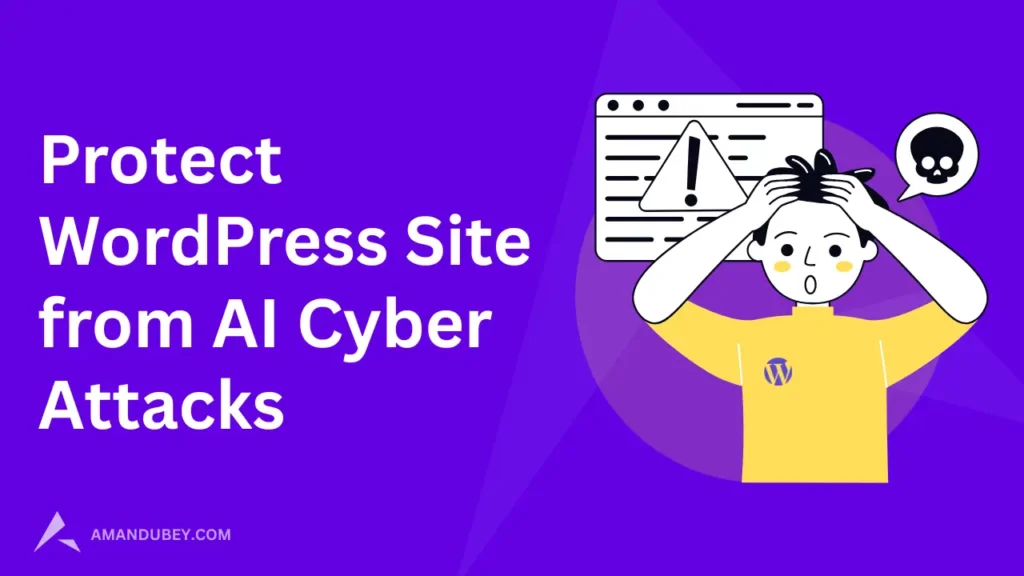In today’s digital world, WordPress is one of the most popular platforms for building websites.
Its ease of use and flexibility make it a top choice for millions of people, from small business owners to large organizations.
However, with this popularity comes a major drawback: the increased risk of cyberattacks. And now, these attacks are becoming smarter, thanks to the rise of artificial intelligence (AI).
AI-driven cyberattacks are more advanced and harder to detect than traditional attacks. They can learn from your site’s behavior and quickly adapt to bypass security measures.
Whether it’s automated brute force attacks, AI-powered malware, or even advanced phishing schemes, these threats are growing more sophisticated each day.
This makes it even more important for WordPress site owners to step up their security game.
In this blog, we’ll walk you through practical steps you can take to protect your WordPress site from these AI-driven threats.
We’ll break it down in simple terms and show you how to easily secure your site against these evolving dangers.
By taking a few key actions, you can keep your site safe and ensure that your data stays protected. Let’s get started with the basics of safeguarding your WordPress website!

Understanding AI-Driven Cyber Threats
Before we dive into protection strategies, it’s important to understand how AI is being used in cyberattacks.
AI tools allow attackers to automate and scale attacks at an unprecedented rate, making them harder to defend against.
1. AI-Powered Phishing
Phishing attacks are one of the oldest and most effective forms of cybercrime. Traditionally, these attacks involved fake emails designed to trick users into providing sensitive information like passwords and credit card details.
However, AI has taken phishing to the next level. AI-powered tools can now craft highly personalized phishing emails that are more convincing than ever before.
They analyze a user’s online activity and behavior to create messages that feel real, making them harder to spot.
2. Automated Brute Force Attacks
Brute force attacks involve attackers trying different combinations of usernames and passwords until they find the right one.
AI has made brute force attacks faster and more efficient. Instead of manually guessing passwords, AI algorithms can now automate the process and perform millions of guesses in a short amount of time, significantly increasing the chances of a successful attack.
3. Deepfake and Impersonation
AI tools are also being used to create “deepfakes” realistic but fake videos or audio recordings of individuals.
Cybercriminals can use deepfake technology to impersonate site owners or trusted authorities, potentially leading to fraudulent transactions or security breaches.
How to Protect Your WordPress Site
Now that we understand the threats, let’s focus on how to protect your WordPress site from AI-driven cyber attacks.
1. Use Multi-Factor Authentication (MFA)
One of the easiest ways to protect your WordPress site is by enabling multi-factor authentication (MFA).
MFA adds an extra layer of security by requiring a second form of verification (such as a text message or authentication app) in addition to your username and password.
Even if cybercriminals manage to crack your password, they won’t be able to access your site without the second factor.
2. Create Strong Passwords and Change Them Regularly
AI-powered brute force attacks rely heavily on weak passwords. Avoid using simple passwords like “123456” or “password.” Instead, create complex, unique passwords for each account.
A good password should include a mix of uppercase and lowercase letters, numbers, and symbols.
Additionally, make sure to change your passwords regularly to minimize the risk of unauthorized access.
3. Limit Login Attempts
Brute force attacks are a major threat to WordPress sites, but you can reduce the risk by limiting login attempts.
There are plugins available that can help you restrict the number of times a user can try to log in before they’re temporarily blocked.
This will prevent automated bots from making endless guesses at your login credentials.
4. Change Default Login URL
Changing the Default Login URL can be a life saver, as we have seen this with our sites too.
The default WordPress login URL (wp-login.php) is widely known, making it a prime target for cybercriminals.
By changing the login URL, you obscure the entry point and make it harder for attackers to target your site.
There are plugins that can help you easily change your login URL, adding an extra layer of protection.
5. Keep WordPress Core, Themes, and Plugins Updated
One of the most common ways hackers exploit WordPress sites is by taking advantage of vulnerabilities in outdated themes, plugins, or even the WordPress core itself.
Keeping everything up-to-date ensures that any security patches or fixes are applied promptly.
WordPress also offers automatic updates for minor releases, which can help keep your site secure without requiring manual intervention.
6. Use AI-Powered Security Plugins
Ironically, AI can also be used to protect your WordPress site. Several security plugins leverage AI to detect suspicious activity and prevent potential threats.
These plugins can analyze traffic patterns, identify unusual login attempts, and block malicious IP addresses.
Some popular AI-based WordPress security plugins include Wordfence, Sucuri, and MalCare.
7. Implement a Web Application Firewall (WAF)
A Web Application Firewall (WAF) sits between your site and its visitors, filtering out malicious traffic before it reaches your site.
A WAF is particularly useful in blocking AI-driven bots that try to exploit vulnerabilities. WAFs can prevent SQL injections, cross-site scripting (XSS) attacks, and brute force login attempts, all of which are common threats.
8. Backup Your Site Regularly
Backing up your WordPress site regularly is crucial in case of a cyber attack. If your site is compromised, having a backup allows you to restore it to its previous state quickly.
Use plugins like UpdraftPlus or VaultPress to automate backups and store them in secure locations like cloud storage.
9. Monitor Your Site’s Activity
Proactive monitoring can help you spot suspicious activity early. Set up tools that alert you whenever there’s an abnormal login attempt, a change in file structure, or any unusual behavior on your site.
By catching issues early, you can mitigate potential threats before they cause damage.
10. Educate Users and Administrators
Cybercriminals often rely on social engineering tactics to exploit vulnerabilities.
Educating your team and users about the dangers of phishing attacks, suspicious links, and secure browsing practices can significantly reduce the risk of a breach.
Additionally, use role-based access control (RBAC) to limit who can access sensitive parts of your site.
11. Have an Incident Response Plan
No matter how secure your site is, there’s always a chance that a cyber attack could occur. Having an incident response plan in place ensures that you’re ready to respond quickly.
This plan should include steps like isolating the compromised system, identifying the attack source, and notifying relevant parties.
Top Security Plugins for WordPress (with AI or Advanced Features)
1. Wordfence Security
Why it’s great: One of the most popular security plugins with an advanced firewall and malware scanner.
AI/Advanced Features:
- Real-time threat defense feed
- Live traffic monitoring
- Brute force attack protection
2. MalCare Security

Why it’s great: Uses intelligent scanning algorithms to detect complex malware that others might miss.
AI/Advanced Features:
- Machine learning-based malware detection
- One-click malware removal
- Login protection and firewall
3. Sucuri Security

Why it’s great: A cloud-based website security platform that provides robust protection.
AI/Advanced Features:
- Cloud-based firewall (WAF)
- Server-side scanning and malware cleanup
- Monitors for DNS and file integrity changes
Final Words
As AI continues to evolve, so do the tactics used by cybercriminals. What once were simple brute force or phishing attempts have now become sophisticated, AI-driven attacks capable of bypassing traditional security measures.
For WordPress site owners, this means that basic protections are no longer enough.
Fortunately, by understanding how AI is being leveraged in cyberattacks and taking proactive steps, such as enabling multi-factor authentication, using AI-powered security plugins, limiting login attempts, and regularly backing up your site, you can significantly reduce your vulnerability.
Cybersecurity is no longer optional; it’s a critical responsibility. The good news is that you don’t need to be a tech expert to implement strong defenses.
With the right tools, habits, and awareness, you can protect your WordPress site from even the most advanced AI-powered threats and ensure your content, data, and users remain safe.
More to read:



